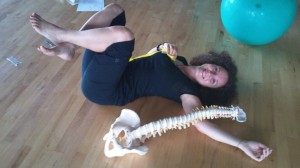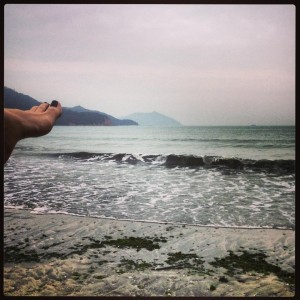I came across a wonderful article LET IT R.A.I.N written by Rick Hanson, (Phd Neuropsychologist; Author, ‘Hardwiring Happiness’) asking: “what can we do to reclaim, use, enjoy, and be at peace with our whole estate — without being overwhelmed by its occasional swamps and fumes? In other words, how can you be “at home in your own skin or your own mind”?
It is true and often emphasized that positive thoughts make us feel good. We have this great ability to work on the mind to improve one’s quality of life.However, are positive views and thoughts, when shaped only from the mental activity, sustainable in time? I believe not.
I believe they must be felt deeply in and arise from the body. This is a process that happens spontaneously in the field of Somatic body-work .
‘Somatic’ means “relating to the body, especially as distinct from the mind”. Somatic body-work aims at “changing the basic shape and structure we have adopted over time, based on our response to experiences, both internal and external”. Whatever happens in your life is preserved not only in your memory but in all the cells of the body. The mind processes and releases experience through therapy, however, the body takes longer to let go. Sometimes it will need to complete a defensive-protective response, other times, there may be crying, or sleeping for days. There is no point repressing an instinct, repeating a positive affirmation if the body is not ready to believe and feel it fully. In the same way, once a positive experience is embodied (fully felt from the body senses) it supports the brain in taking in and appropriating new positive meanings by anchoring new neural pathways.
Have you ever tried to feel grateful and wondered why you are not able to?
In my experience gratefulness arises from a blissful state of aliveness, that arises when we are fully available to feel and engage in life, in the moment present . A psycho-biological state of relaxed alertness.
As the Author goes on “Sure, the processes of the psyche need some regulation. Not all thoughts should be spoken, and not all desires should be acted upon! But if you suppress, disown, push away, recoil from, or deny major parts of yourself, then you feel cut off, alienated from yourself, lacking vital information about what is really going on inside, no longer at home in your own skin or your own mind — which feels bad, lowers effectiveness at home and work, fuels interpersonal issues, and contributes to health problems.”
How to break the cycle? One cannot learn nor unlearn the old patterns, without the body.
In my, hopefully correct, interpretation of the tools presented in the article here, I appreciate the invitation of a mind-body based way of experiencing one’s reality by simply BEING with what arises and holding a space in the body for it: by letting it R.A.I.N , one allows space and neutrality, open awareness ( the mind itself –often called ego- is gently and continuously put aside) to observe one’s experience in the present moment of one’s history. Being in the NOW, you ARE, alive, if you can feel that, than that’s how your body helps you process. This creates a virtuous circle. As the mind is tamed, the physiology as well shifts to a resting place, this more stable body then gives sensory feed back to the brain: I am safe, here and now.
Sustaining this awareness gives the autonomic nervous system room to shift the body to a restorative phase. You can train yourself, noticing how your thoughts and body sensations are linked together, paying curious playful attention to the unvoluntary movement of life energy, the little shifts in your body sensations to a better place.

How does your body let you know that you are OK, that things are BETTER NOW? That you are alive? How does it change your mindset?
Experiencing this natural aliveness phenomenon (calmer breath, longer exhales, guts relaxing, heart rate slowing) , allows you to gain a stronger connection with yourself, self-understanding, and supportive body presence. It uses the body’s capacity to be a container to hold and transform in the here and now the nervous system energy, balance the effects on the body physiology of all the experiences lived and remembered. Being fully with the rain, our body sinks in and embraces the reality of the experience, as does the mind. Keep on being connected with your life, in whatever circumstances, recovering from the breakdowns.
If for only 5 minutes a day, I highly recommend this practice to you! Take some time to notice your body shifting to a resting place of relaxed alertness. It is possible to feel good and bad at the same time. Watch yourself, as you would do for a loved one, with patience, self-compassion, openness, curiosity, non-judgement, as this too will pass, like the rain. Vitality is then seen from the perspective of the capacity to move through breakdowns, to adapt to change and the environment. Health, quietness, in the body and mind, is lived as a movement, with its ups and downs, and embracing all aspects of the self. I am looking forward to hearing from your experiences and questions.

“R.A.I.N is an acronym developed by Michelle McDonald, a senior mindfulness teacher, to summarize a powerful way to expand self-awareness. R = Recognize: Notice that you are experiencing something, such as irritation at the tone of voice used by your partner, child, or co-worker. Step back into observation rather than reaction. Without getting into story, simply name what is present, such as “annoyance,” “thoughts of being mistreated,” “body firing up,” “hurt,” “wanting to cry.”
A = Accept (Allow): Acknowledge that your experience is what it is, even if it’s unpleasant. Be with it without attempting to change it. Try to have self-compassion instead of self-criticism. Don’t add to the difficulty by being hard on yourself.
I = Investigate (Inquire): Try to find an attitude of interest, curiosity, and openness. Not detached intellectual analysis but a gently engaged exploration, often with a sense of tenderness or friendliness toward what it finds. Open to other aspects of the experience, such as softer feelings of hurt under the brittle armor of anger. It’s OK for your inquiry to be guided by a bit of insight into your own history and personality, but try to stay close to the raw experience and out of psychoanalyzing yourself.
N = Not-identify (Not-self): Have a feeling/thought/etc., instead of being it. Disentangle yourself from the various parts of the experience, knowing that they are small, fleeting aspects of the totality you are. See the streaming nature of sights, sounds, thoughts, and other contents of mind, arising and passing away due mainly to causes that have nothing to do with you, that are impersonal. Feel the contraction, stress, and pain that come from claiming any part of this stream as “I,” or “me,” or “mine” — and sense the spaciousness and peace that comes when experiences simply flow.
R.A.I.N. and related practices of spacious awareness are fundamental to mental health, and always worth doing in their own right. Additionally, sometimes they alone enable painful or challenging contents of mind to dissipate and pass away.
It is not enough to simply be with the mind, even in as profound a way as R.A.I.N. We need to work with the mind, by reducing what’s negative and increasing what’s positive. It’s also necessary to work with the mind to build up the inner resources needed to be with it; being with and working with the mind are not at odds with each other as some say, but in fact support each other.
And whatever ways we work with the garden of the mind — pulling weeds and planting flowers — will be more successful after it R.A.I.N.s.”
Read the full article and learn more about Mr Rick Hanson’s work here.
More about relaxed alertness from an educational perspective for children here.